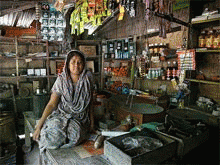rong>
(Originally published: Yes! Magazine)
Unraveling the confusion behind microcredit: how some models help alleviate poverty, while others exploit the poor to make the rich richer.
For more than twenty years, microcredit has been widely heralded as the remedy for world poverty. Recent news stories, however, have sullied microcredit's glowing reputation with reports on scandals, exorbitant compensation to managers, skyrocketing interest rates, and aggressive marketing schemes.
Once praised as a universal panacea, microlenders are now being widely attacked as predatory loan sharks. In December 2010, Sheik Hasina Wazed, the prime minister of Bangladesh and former microcredit advocate, accused microcredit programs of "sucking blood from the poor in the name of poverty alleviation."
What happened?
It turns out there are two very different models of microcredit. As Muhammad Yunus, winner of the 2006 Nobel Prize, pointed out in his January 15, 2011 New York Times op-ed, one type of microcredit program is designed to serve the poor; another to maximize financial returns to program managers and Wall Street investors.
The differences raise crucial questions for the future directions of microfinance. They also help us see where the banking system here in the United States went off course and how we must restructure it to support prosperous Main Street economies.
Grameen as a Model Community BankIn 1983 Yunus founded the Grameen Bank, universally cited as the inspiration and model for the global microcredit movement. His purpose was to improve the lives of millions of poor Bangladeshis by making small loans to poor women to fund income-generating microbusinesses.
The basis for the Grameen Bank's worldwide renown lies in a number of key characteristics that are not widely understood.
- Most local branches are self-funded by deposits of their local members in taka, the Bangladesh national currency.
- By serving as a depository for its members, Grameen Bank allows the poor to build their own financial asset base.
- The bank extends loans to its members at a maximum interest rate of 20 percent, a fraction of what many other microlenders charge.
- Operating
on a cooperative model, profits are redistributed to the Grameen Bank's
owner-members or are invested in community projects.
These features root the Grameen Bank in the community it serves and keep money, including interest payments, continuously circulating locally to facilitate productive local exchange and build real community wealth.
Microcredit programs seeking to replicate the Grameen model have spread rapidly across the globe. Most, however, replicate only the loan feature. Few provide their members with depository services or replicate the Grameen Bank's other defining features, though these features are central to its commitment to community wealth building.
The Turn to Wall StreetAs microlending programs became increasingly focused on repayment rates and growing the size of their loan portfolios, they looked for new sources of capital to expand their reach. With encouragement from foreign philanthropists, many turned to foreign commercial equity investors. Since private equity conflicts with the nonprofit model, sometime around 2005 many nonprofit microcredit programs changed their status to for-profit enterprises and converted their philanthropic nonprofit assets into private for-profit assets.
One such micro-finance program was Compartamos in Mexico, which in 2007 launched an initial public stock offering. According to a New York Times article, it charged its borrowers an annual interest rate of near 90 percent, producing a return on equity of more than 40 percent, nearly three times the 15 percent average for Mexican commercial banks. This made Compartamos highly attractive to private equity investors. The public offering brought in $458 million, of which "private Mexican investors, including the bank's top executives, pocketed $150 million."
Another example is SKS Microfinance in India, whose initial public offering in August 2010 raised $358 million from international investors and yielded its founders stock options worth more than $40 million.
Yunus describes the consequences of such conversions and public sales:
(Note: You can view every article as one long page if you sign up as an Advocate Member, or higher).





